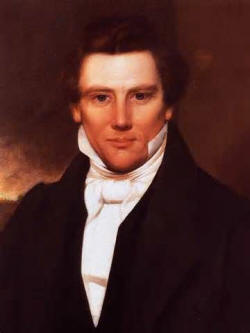
History: Mormon Temple Near Greenwood, Wisconsin
Contact: Kris Leonhardt
Surnames: Jurgaitis, Young
----Source: Atwood Studio by Kris Leonhardt, Photos are courtesy of Mary Jurgaitis
Mormon temple finds its roots near Greenwood
The majestic Nauvoo Temple sits high above the running waters of the Mississippi River on a bluff overlooking a bend in the historic waterway. This 54,000 square foot beauty is a near exact replica of its predecessor which, although hundreds of miles away, finds its “roots” in the Northwoods of Clark County.
“The Mormon Logger Missionaries came to the ‘Wisconsin Pineries Mission’ to specifically harvest the white pine for lumber to build two buildings in Nauvoo, Illinois: the Nauvoo House, which was to ‘be for a house for boarding, a house that strangers May come from afar to lodge therein; therefore let it be a good house, worthy of all acceptation, that the weary traveler May find health and safety while he shall contemplate the word of the Lord; and the cornerstone I have appointed for Zion.’ and most importantly, the other building was the Nauvoo Temple, which was a house built to The Lord,” explains Mary Jurgaitis, a leader of a local group dedicated to “Remembering the Mormon Loggers of the Wisconsin Pineries”, quoting then leader Joseph Smith.
After purchasing the city of Commerce in Illinois, and changing its name to Nauvoo, Mormon Logging Missionaries traversed the Mississippi River to La Crosse, then navigated the waters of the Black River to reach Jackson County, before arriving in the Clark County area. Here the loggers set up four camps: one on the Black River near Wedges Creek, one at Ross’ Eddy (Neillsville), one at Weston Rapids, as well as one where the city of Greenwood now stands.
“Most of the Mormon Logger Missionaries were here for only a period of time -- generally one season to harvest the timber during the winter, get it all down to the saw mills in Black River Falls in the spring, then float with the lumber rafts down the Mississippi to Nauvoo. Then others would come up to the camps and sawmills, bringing supplies and replacing the previous workers,” adds Jurgaitis. “Some of the Mormon Logger Missionaries felt this might be a good area to establish an arm of The Church of Jesus Christ of Latter-day Saints. Therefore some, with their families, began building homes and encouraging others to come.”
During the early 1840s there was not much more to be found in the Clark County area, but the occasional fur trapper, so the loggers were destined to encounter many hardships upon their arrive.
“It was four hundred miles from Nauvoo to this area. Many came during the winter months and were plagued by the cold and deep snow. Food during the first two years was very sparse. Food & supplies took about six weeks, sometimes more, to reach the most northern workers,” says Mary. “Sometime during the second year, crops were planted for future use. By the third year, food was still brought up, but the crops began producing and providing for those who were now in the Wisconsin Pineries.”
“Another difficulty was the relations with the Native Americans,” she adds. “In the beginning they threatened to burn down the sawmills. Then a man by the name of George Miller, who had the responsibility to make the Wisconsin Pineries mission work, developed a very good relationship with them.”
By 1843, they had decided that the area might be a good location. “Then the thing that changed everything was the murder of (we say the martyrdom of) Joseph Smith in June of 1844. Joseph Smith had been and was the leader of The Church of Jesus Christ of Latter-day Saints since its founding in1830,” explains Mary.
Brigham Young, the man who was to become leader, wanted to see the temple completed, so logging continued in the Northwoods; however, a conflict in leadership caused many groups to break away and form new settlements during this time.
“Some of these stayed in Wisconsin and "settled" in various areas, but not in Clark County. None were truly successful. As a result there really wasn't a "Mormon settlement" here,” says Jurgaitis. “Most of the loggers, workers, and the families that were with them returned to Nauvoo. A few stayed individually and melted into the population of Black River Falls, La Crosse and other nearby areas.”
Back in Nauvoo, the Mormons, were experiencing great oppression. “(An) extermination order was issued and the mobs in the Nauvoo area began wreaking great havoc. Either the citizens leave or all be killed,” states Jurgaitis. It was then that the Mormon settlement at Nauvoo made plans to move west.
The great Nauvoo Temple, built by the back-breaking labor of missionary loggers out of the lumber harvested in the Clark County area, was destroyed by arson in 1848 and later finished off by tornadic winds in 1850.
In 1999, a replica of the original was raised and remains one of two operating Mormon Temples built in Illinois, as well as a testament to the early struggles of its founders.
Back in Clark County, a single Historical Marker located in Greenwood City Park, indicates the significance of the area around Wedge’s Creek and its hometown which once held the promise of a new Mormon home.
|
© Every submission is protected by the Digital Millennium Copyright Act of 1998.
Show your appreciation of this freely provided information by not copying it to any other site without our permission.
Become a Clark County History Buff
|
|
A site created and
maintained by the Clark County History Buffs
Webmasters: Leon Konieczny, Tanya Paschke, Janet & Stan Schwarze, James W. Sternitzky,
|